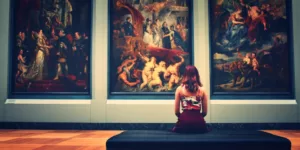The entire Presidential Committee on the Arts and Humanities resigned last week, throwing another cog into the Trump Administration machine. One of the reasons cited was President Trump’s budget, which would slash federal spending on the arts and humanities. Federal subsidies are critical to maintaining and refreshing the lineup at museums and art galleries, as well as paying dedicated staff.
But Trump is not the first politician to threaten the arts, and Europe is not immune to it. Curators of art are not quick-to-fill positions in any country. Museum curation is not a simple profession. Handling the art galleries of Europe is a delicate job that few have the privilege to enjoy at high levels.
Curators protect, preserve, and expose work, serving the artist as much as the public. They catalyze interest in art, adding prestige to it by selecting it as part of a greater exhibition or merely placing it in the same hallowed halls as more legendary painters and sculptors. A few superstars have become notable contributors to the field, famous for their handling of large and valuable collections.
There are big players like former Hamburger Kunsthalle Director Xavier Bray, whom Lloyd’s Bank director António Horta Osório appointed head of the Wallace Collection in London last year; OkwuiEnwezor at Haus der Kunst in Munich; U.S.-born Elena Filipovic at Kunsthalle Basel in Switzerland; and Digital Curator at Serpentine Galleries, Ben Vickers in London.
One has to have an eye for it. As Serpentine Galleries curator Hans Ulrich Obristtold the Guardian recently, there are four critical elements in curation: preservation, selecting new work, connecting to art history, and arrangement.
“Before 1800, few people went to exhibitions. Now hundreds of millions of people visit them every year. It’s a mass medium and a ritual. The curator sets it up so that it becomes an extraordinary experience and not just illustrations or spatialised books.”
That being said, the arts are always looking over their shoulders to ensure no one is cutting grants. A tight economy will always threaten art as a priority, or the availability of private donations.
“With government cuts facing our sector over the coming years, make sure that being a curator is something to which you’re totally committed,” Daniel Martin, curator of making at Derby Museums, told the Guardian last year. “There will be lots of short-term contracts and project-related work throughout your career. Curating is no longer a suitable choice for those seeking long-term stability.”
There are special curation-focused courses beyond the standard art history programs at major universities. Brad Graduate Center in New York and the Node Center for Curational Studies in Berlin offer such tracks. Node Center co-founder Perla Montelongo told the New York Times the program would “bring the curator back down to earth,” hopefully on two firmly placed feet ready to encounter the changing economic and cultural landscape of the 2010s.
The new fractious politics (and economics) of post-Brexit Europe and Trump’s America make concentration on the arts difficult. The world’s up-and-coming curators will have little choice but to press on. Despite the pressures of the industry, someone will have to preserve and highlight art for future generations.








